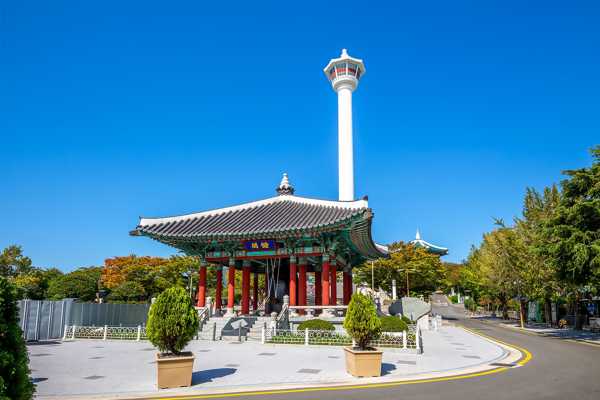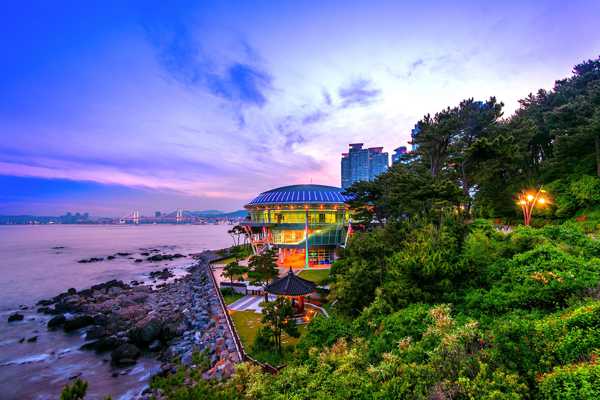Adjacent to the sea, Busan is famous for its seafood dishes. In addition, as refugees began to settle in Busan during the Korean War, food cultures of various regions mixed and developed into a unique food culture of this city. As a result, there are many dishes that can only be tasted in Busan. In particular, dwaeji gukbap, which is a pork bone soup served with steamed rice and pork slices, is a dish that represents Busan. Although being just a bowl of soup and rice, the rich broth and a generous serving of meat make it a hearty meal.
Busan, a city offering an array of seafood, is famous for saengseonhoe (sliced raw fish). But, eomuk (fried or steamed fish cake) must not be missed either. Busan is the place to enjoy eomuk, which boasts a tradition of almost one hundred years in this city. Don't forget to taste other specialities of Busan during your trip.
- 1
Dwaeji gukbap
A tasty combination of pork meat and bone, water, and fire

- Mat
Dwaeji gukbap (pork and rice soup) has been a dish familiar to people of all ages in Busan as well as Gyeongsang Province. This unique soup is one of the most representative local foods of the region and there is even Dwaeji Gukbap Street in Busan. The custom of serving soup with rice dates back even before the Joseon era. The exact origin of this dish is still unknown, but it is widely accepted that it is a by-product of the aftermath of the Korean war which included mass evacuation to Busan, rather than being a local food spontaneously developed in the region.
Seomyeon Dwaeji Gukbap Street in Seomyeon Market is packed with restaurants serving this soup, becoming Busan's best-known speciality. The large pots boiling pork in front of these restaurants always catch the eyes of passersby. Dwaeji gukbap may appear to be quite a simple dish, but each restaurant has a slightly different recipe. Enjoy the soup the way you like it.
- 2
Milmyeon
Sweet, sour, and spicy cold noodles native to Busan

- Mat
Milmyeon is a type of cold noodle dish enjoyed by Busan residents in summer. A representative native food of Busan, it evokes feelings of nostalgia in anyone born and raised in the city, especially when summer arrives. Milmyeon is one of the local dishes first enjoyed by refugees during the Korean War, along with gupo guksu and dwaeji gukbap. The chewy noodles are made by pressing dough made with wheat flour or a mixture of wheat flour and starch onto a noodle mould.
Milmyeon is an inexpensive dish as it uses very popular ingredients. Also, thanks to its simple recipe, it can be cooked and served quickly. For this reason, milmyeon has become one of the most popular dishes with everyday people, suited to their food culture. Try milmyeon, which has a unique sweet, sour, and spicy taste and a refreshing, clean aftertaste at the same time.
- 3
Bibim dangmyeon
Chewy glass noodles with spicy sauce and fish cakes

- Mat
Bibim dangmyeon, a local dish in Jung-gu, Busan, consists of boiled glass noodles served with spicy sauce and various toppings. It is said to have originated from the custom of making noodles with starch powder extracted from sweet potatoes during the Korean War when food was scarce. It is a local food that can be eaten instantly, appealing to customers who prefer food served quickly and with a spicy taste.
There are many restaurants serving bibim dangmyeon all around Busan, but the one at Kkangtong Market is regarded as the original. The dish is served as a bowl of boiled and cooled-down glass noodles topped with thinly sliced flat fish cakes, pickled radish, and boiled chives. The combination of glass noodles and fish cakes has captivated the taste buds of many people. In addition to bibim dangmyeon, another variation, muldangmyeon, is served with broth. Try these two representative local foods of Busan at Kkangtong Market.
Foto: Mobius6 (CC BY-SA 4.0) retusjert
- 4
Busan eomuk
A symbol of Busan with a 100-year history

- Mat
The history of Busan eomuk (fish cakes), a specialty of Busan, goes back to the Joseon period. Some insist that Japanese foods such as kamaboko and oden introduced by Japanese immigrants who came to Busan during the Japanese Occupation were the origin of eomuk, but there are historical records that fish cakes similar to today's eomuk had already existed in Joseon. Thanks to the efforts of local companies to preserve the value of Busan eomuk, it has re-established its reputation as a premium local food brand.
There are many famous eomuk restaurants in Busan, including Marathon in Bujeon-dong, Beomjeon Oden in Nampo-dong, and Miso Oden in Daeyeon-dong. Most of these restaurants serve alcoholic drinks along with various foods including eomuk. Try warm Busan eomuk with a drink on a cold winter's day. It will add an unforgettable memory to your trip to Busan.
Foto: bryan... (CC BY-SA 2.0) retusjert
- 5
Ssiat hotteok
A local food with a unique chewy texture

- Mat
Ssiat hotteok must not be left out when discussing the street foods of Busan. It is known that refugees who fled to Busan during the Korean War started making hotteok (Korean pancakes) stuffed with various grain seeds. Then, in the late 1980s, hotteok with mixed nut fillings began selling in Nampo-dong, which marked the birth of ssiat hotteok. Busan's ssiat hotteok is characterized by a greasy and chewy texture. Instead of being oven-baked, the dough is pressed and fried on a griddle greased with cooking oil and then cut down the middle and stuffed with different varieties of nuts.
Its unique chewy texture and nutty taste became known across the country by word of mouth, making ssiat hotteok a must-try speciality of Busan. Enjoy its special taste at Busan Gukje Market, which is famous for ssiat hotteok along with Namdaemun Market in Seoul.
- 6
Sliced raw fish
Taste fresh raw fish and seafood prepared to order

- Mat
Busan is indisputably Korea's mecca for raw fish cuisine. Close to the fishing grounds, the city is abundant with various kinds of fresh fish and seafood that are less stressed out during transit, and thus retain the natural elasticity and density of the flesh, which affect the taste. Also, as only few of them perish during transport, live fish can be supplied at relatively affordable prices. With the remarkable seascape that customers can see in most local seafood restaurants, Busan has gained its reputation as the nation's centre of raw fish cuisine. Of all the many festivals related to beaches and seafood in Busan, the Busan Jagalchi Festival is the most famous, offering an array of tasting experiences.
There are several popular markets in Busan such as Gukje Market and Kkangtong Market, but Jagalchi Market provides an unrivalled selection of raw fish and seafood. You can relish freshly sliced raw fish at Jagalchi Market Hoe Centre, which also has a roof garden where you can appreciate the seascape. In Busan, enjoy many different fresh raw fish dishes with the beautiful ocean as the backdrop.
- 7
Pajeon
Busan's traditional food enjoyed by the king

- Mat
Dongnae pajeon (green onion pancakes) is made with glutinous rice flour, non-glutinous rice flour, and plenty of green onions. The dish often contains various kinds of seafood such as clams, mussel, oysters, and shrimp, so it is often called haemul pajeon (seafood and green onion pancake) as well. Dongnae pajeon is believed to have originated from a dish eaten to commemorate the victory over the Japanese army who invaded Dongnae Fortress during the Imjin War in 1592 by locals throwing green onions at the enemy. Others insist that this dish became famous along with the word "Dongnae gisaeng" when gisaeng (female entertainers) from Dongnae came to Busan after the Korean War and opened high-end restaurants that served pajeon.
Dongnae pajeon, filled with moist and sweet green onion and fresh seafood, goes well with soy sauce or red chilli-pepper paste with vinegar. It is best paired with Geumjeongsanseong makgeolli, Busan’s representative traditional rice wine. Don't miss visiting Dongnae and trying pajeon when you're in Busan.
- 8
Street toast
A quick, tasty meal at an affordable price

- Mat
On the streets of Busan, you can easily find small snack bars or food stalls that serve street toast. The most famous spot for such unique toast is likely the street in front of the main gate of Pusan National University. The special three-layer toast with hearty fillings―ham, bacon, shredded cabbage, and scrambled eggs―is very popular with students on a tight budget. Freshly made to order, it’s not just warm, but hot. It makes a good snack between meals for young people who feel hungry even after eating, or a hearty meal for those who eat light.
Compared to fancy sandwiches served by cafes and restaurants, street toast is truly affordable with a familiar, nostalgic taste. The unique taste and feelings evoked make street toast popular with foreign tourists visiting Korea.
- 9
Chimaek
A popular pairing of savoury fried chicken and refreshing beer

- Mat
Chimaek, which has recently created a craze in and out of Korea, is a popular food pairing in Busan as well. It is not clear why this chimaek craze first started in Korea since fried chicken and beer are enjoyed in almost every part of the world. The reason may be because, in other countries, people believe the greasiness of fried chicken would spoil the aroma of beer, while Koreans think cold carbonated drinks including beer would refresh their palate from the fattiness of fried chicken.
Bupyeong Kkangtong Market in Nampo-dong is one of top chimaek spots in Busan. At night, the market is crowded with people enjoying chimaek. On hot summer nights, it is often difficult to find a table in a popular chimaek restaurant or pub. There are many hot chimaek spots in Busan, one of which is Haeundae Beach.
- 10
Naengchae jokbal
A unique combination of chilled jellyfish salad and braised pigs' feet

- Mat
Naengchae jokbal, unlike the typical jokbal, (braised pigs' feet) is served with a chilled jellyfish salad and special sauce. It is known to have been first served on Jokbal Street in Bupyeong-dong, Jung-gu, Busan. Enjoyed with cucumbers, carrots, lettuce, jellyfish and mustard sauce, naengchae jokbal has a cool, chewy, crispy sensation that is pleasantly blended with the tanginess of wasabi.
Jokbal Street was born about three decades ago when a number of jokbal restaurants popped up near Gukje Underground Shopping Centre to the west of Gwangbok-ro Street to Bupyeong intersection. As the origin of naengchae jokbal, these restaurants attract many customers from all around the country and nearby countries such as Japan on weekends. Try this unique dish with an unusual taste at its birthplace, Jokbal Street.


















